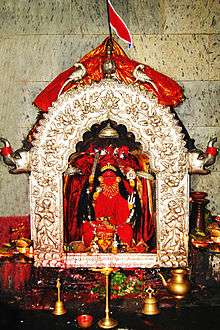Chausathi Jogini Temple (Hirapur)
Chausathi Jogini Mandir (64 Joginis Temple) is situated in a hamlet called Hirapur,[1] 20 km outside Bhubaneswar, the capital of Odisha state of Eastern India.[2]
| Chausathi Jogini Temple | |
|---|---|
ଚଉଷଠି ଯୋଗିନୀ ମନ୍ଦିର, ହୀରାପୁର | |
Chausathi Jogini Temple, Hirapur | |
| Religion | |
| Affiliation | Hinduism |
| District | Khurda |
| Deity | Kali |
| Festivals | Kali Puja |
| Location | |
| Location | Hirapur |
| State | Odisha |
| Country | |
 Location within Odisha | |
| Geographic coordinates | 20°13′35.454″N 85°52′32.141″E |
| Architecture | |
| Type | Hypaethral |
| Specifications | |
| Temple(s) | 2 |
| Monument(s) | 3 |
| Elevation | 17 m (56 ft) |
Religious aspect
64 Joginis Temple is a tantric temple,[3] with hypaethral (roofless) architecture as tantric prayer rituals involve worshiping the bhumandala (environment consisting all the 5 elements of nature - fire, water, earth, sky and ether).
The Jogini idols are generally representing a female figurine standing on an animal, a demon or a human head depicting the victory of Shakti (Feminine power). The idols express everything from rage, sadness, pleasure, joy, desire and happiness.[2] The number 64 finds its reference in Hindu mythology in various forms viz Kālá for time, Kalā for performing arts etc.
Such temples dedicated to joginis are also seen at Ranipur-Jharial site of the Balangir district in Odisha and seven other places in India.
History
The temple is believed to be built by the Queen Hiradevi of Bramha dynasty during the 9th century.[4]
The legend behind the temple according to local priests is of the Goddess Durga taking the form of 64 demi-goddesses in order to defeat a demon. After the fight the 64 goddesses (Joginis) asked Durga to commemorate them in the form of a temple structure.[2]
The temple complex is now maintained by Archaeological Survey of India.
Architecture
The temple is built in a circular fashion, completely put together with blocks of sandstone. The inside of the circular wall has cavities, each housing the statue of a Goddess. There are around 56 such idols, made of black granite, inscribed within the wall cavities, centring on the main idol which is the Goddess Kali, who stands on a human head representing the triumph of the heart over the mind. The temple houses a central altar (Chandi Mandapa) which has the remaining 8 Goddess idols on all 4 sides. Some historians believe that an idol of Maha Bhairava was worshiped in the Chandi Mandapa.[4]
- The Jogini idols
- Yoginis in a circular format
References
- "Orissa Review, Government Gazette". Orissa Review. Home Department, Government of Orissa. 43: 30. 1986.
- "Chausathi Yogini Temple – A Place of Wondrous Occult - Sand Pebbles Tour N Travels". Sand Pebbles Tour N Travels. 15 June 2014. Archived from the original on 20 December 2016. Retrieved 6 December 2016.
- "Yogini temple of Hirapur". The Hindu. 17 October 2003.
- Saravanan, V. Hari (2014). Gods, Heroes and their Story Tellers: Intangible cultural heritage of South India. Notion Press. ISBN 9384391492.
Further reading
- Adyasha Das (2019). The Chausathi Yoginis of Hirapur: From Tantra to Tourism. Black Eagle. ISBN 978-1-64560-012-1.
External links

- Detail Study
